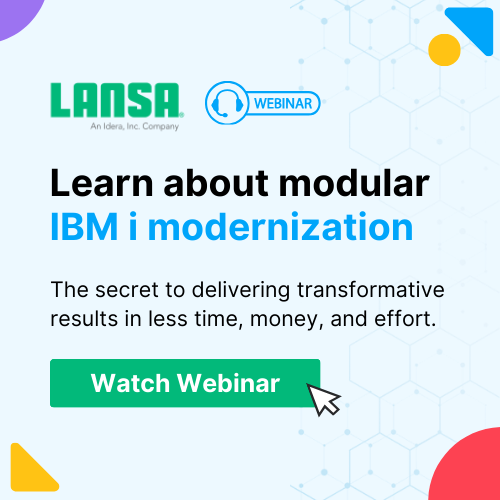“Legacy application modernization” has become a buzz phrase in the software development industry. This is because many legacy systems have become a liability rather than an asset in today’s fast-paced world of rapidly changing market conditions and customer expectations.
Before the pandemic, businesses sought ways to innovate and become more agile as an edge over the competition. This often involved large-scale reengineering projects which require large budgets. Coming off one of the worst economic crises in history, however, many believe “doing more with less” is the new prerequisite for survival. Businesses must now innovate faster than ever before, albeit under low-budget conditions. The new focus, therefore, is on minimizing risks and reducing costs by modernizing existing applications.
For many, a big part of legacy application modernization is automating manual processes, moving data freely through internal/external systems, and streamlining business processes.
Business Process Integration (BPI) allows organizations to create connectivity through seamless data sharing across multiple systems. But it’s much more than that. Using BPI, you can reduce the human effort required to complete repetitive tasks and routine transactions. This improves data accuracy and substantially lowers processing costs.
In other words, to do more with less, you need a working BPI strategy. Keep reading to find out how you can define yours.
What are the Key Drivers for Business Process Integration and Modernization?
Before we dive into what a successful BPI strategy entails, let’s discuss the key drivers of business process integration. These include the effectiveness, efficiency, and adaptability of your business processes. The driving forces to reaching these goals are:
- Automation allows for increased productivity and more effective use of existing resources. This reduces your risks and potential points of failure by limiting human intervention.
- Optimization focuses on increasing organizational efficiency by streamlining and improving business processes. This allows you to scale to account for increases in business volume.
- Collaboration involves the interaction between people, processes, and systems to increase the accuracy, timeliness, and completeness of information. Collaboration is necessary internally across business units and externally across the supply chain.
What Does A Successful Legacy BPI Modernization Strategy Entail?
When looking to improve your overall business process, you typically consider these three questions:
- Are you effectively meeting your customers’ needs?
- How efficient are you with existing resources?
- Are you flexible enough to adapt to change quickly?
A successful BPI strategy accounts for these three questions. They apply both to individual business processes and tasks at the macro-level such as supply chain and customer integration.
The need to be agile, operate more efficiently, and collaborate seamlessly cannot be overemphasized. This, together with providing decision-makers and line of business leaders with information when they need it is what keeps successful organizations ahead of the curve.
Internal vs External Data
Corporate information exists internally and externally. An example of data that’s internal to an organization is a merger and acquisition. Company A merges with Company B, each with different ERP and CRM systems, probably running on different hardware in different geographic locations. However, a fluid business process requires all this isolated data to be visible to all business units to facilitate forecasting and decision making.
On the other hand, corporate information existing external to an organization is customer integration data and data shared among trading partners. For example, if Company D outsources its logistics to Company E, E needs to see inventory levels, order fulfillment, and other logistics-related data.
Providing this visibility can seem like an uphill battle for companies running on legacy systems. This is because legacy systems are often monolithic with structures that inhibit data sharing between internal and external systems. Fortunately, legacy application modernization lets you integrate BPI solutions that not only facilitate seamless data exchange and collaboration but also reduce operating costs. While legacy application modernization can seem overwhelming due to the many variables involved, there are many resources to help you get started. One resource is 5 answers to crucial questions about legacy application modernization.
What’s the Difference Between BPI and BPM?
You may have heard about Business Process Management (BPM) before coming across this article. If you are wondering what the difference between BPI and BPM is, then here’s a reasonably simplistic differentiation table.
| BPI | BPM |
| Works between systems | Works between people |
| Integrates existing systems | Architects new systems |
| Provides a highly practical, accessible, and low-risk solution | Typically requires extensive investment in training and toolsets before results can be realized. |
BPI is about connecting systems, whereas BPM involves complex human workflows, modeling, simulation, analysis, data management, and so on. The result of a good BPI is an integrated and streamlined infrastructure, which stems from automating manual, repetitive, or multistep processes. This assumes that the repetitive process is one that can be made more efficient with technology. On the other hand, BPM focuses more on reengineering the target process, which is either broken or insufficient.
BPI is a less “scientific” technology that simplifies and improves business processes but carries a substantially lower price tag, and complexity threshold than the typical BPM
How Can You Do More With Less Using BPI and Legacy Application Modernization?
Legacy application modernization starts with identifying problem areas and developing a working strategy to solve those problems. In our fractured economy, businesses are looking to leverage their existing resources to keep up with rapidly changing market conditions, technology advancements, and evolving customer expectations. The perfect legacy application modernization strategy minimizes risks while making use of those resources.
Business Process Integration (BPI), when implemented correctly, fills this gap. It facilitates the integration of existing systems, reduces processing costs, and improves data accuracy by limiting the human effort required to complete repetitive tasks and routine transactions. Are you looking to get started with BPI? The LANSA host integration solution can help you achieve your goals. You can also contact us to learn more about how we can help you transform your legacy systems with less.










